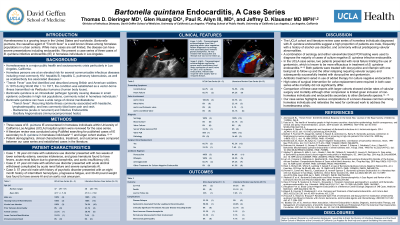Category: Endocarditis
Poster Session: Endocarditis
696 - Bartonella quintana Endocarditis, A Case Series


Thomas D. Dieringer
Infectious Diseases Fellow
University of California Los Angeles
Los Angeles, CaliforniaDisclosure: I do not have any relevant financial / non-financial relationships with any proprietary interests.
- GH
Glen Huang
Fellow
University of California - Los Angeles
Los Angeles, CaliforniaDisclosure: I do not have any relevant financial / non-financial relationships with any proprietary interests.
- PA
Paul R. Allyn
Dr.
UCLA
Los Angeles, CaliforniaDisclosure: I do not have any relevant financial / non-financial relationships with any proprietary interests.
- JK
Jeffrey Klausner
Professor of Medicine, Infectious Disease Specialist
UCLA
Los Angeles, CADisclosure: I do not have any relevant financial / non-financial relationships with any proprietary interests.
Presenting Author(s)
Co-Author(s)
Background:
Homelessness has been a growing issue in the United States and worldwide. Bartonella quintana, the causative agent of “Trench fever”, is a well known illness among homeless populations in urban centers. While many cases of B. quintana are self limited, the disease can have advanced presentations including endocarditis. We present a short case series of three cases of B. quintana infective endocarditis (IE) in homeless individuals in Los Angeles and review the literature of cases of B. quintana IE in the homeless population.
Methods:
Here we report three cases of B. quintana IE encountered in homeless individuals at the University of California, Los Angeles (UCLA) hospital system. A literature review was also conducted. PubMed was searched for published cases of human IE secondary to B. quintana in homeless individuals.
Results:
All three patients were male with ages ranging from 39 to 57 years old with a history of homelessness and alcohol use. Presentations were subacute to chronic in nature consisting of constitutional symptoms as well as a range of symptoms corresponding with heart and renal failure. Each patient was found to have varying degrees of aortic insufficiency with either identified aortic valve vegetation or valvular thickening. Diagnosis was made with a combination of Bartonella serologies and whole genome sequencing PCR. All three patient’s courses were complicated by renal failure at varying points limiting the use of gentamicin for the full treatment course. Two patients ultimately underwent aortic valve replacement due to severe aortic insufficiency and completed therapy with doxycycline and rifampin. A single patient was discharged with plan to complete doxycycline and rifampin therapy however was lost to follow up.
A literature review of 10 manuscripts describing 13 cases of B. quintana IE were identified. All the patients were male and the median age was 45. Six of the cases were in Europe and eight were in North America. All cases had left sided valve involvement (10 aortic, 6 mitral, 3 both valves). No cases of right sided IE were identified.
Conclusion:
B. quintana IE should be considered in homeless patients with a clinical presentation concerning for IE. A combination of serology and PCR testing can be useful in diagnosis of this uncommon cause of infective endocarditis.

